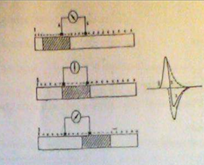3.1 MEASURE OF EXCITABILITY. CHANGES IN EXCITABILITY DURING EXCITATION. INHIBITION. CONDUCTION OF EXCITATION.
1/6
There's no tags or description
Looks like no tags are added yet.
Name | Mastery | Learn | Test | Matching | Spaced |
|---|
No study sessions yet.
7 Terms
section
define excitation
process when there is an electrical stimulus
action potential
saltatory conduction
inhibition
define excitation
excitable cells react to irritation or stimulation
excitation: process of producing an action potential
process when there is an electrical stimulus
when Na+ diffuse inward through the membrane in sufficient numbers can set off automatic opening of the sodium channels.
This can be from mechanical disturbance of the membrane, chemical effects on the membrane, or passage of electricity through the membrane.
A weak or negative electrical stimulus may not be able to excite a fibre.
However, when the voltage of the stimulus is increased, excitation takes place when threshold reached → threshold or super threshold stimulus
At point A – stimulus is too weak, causes membrane potential to change from –95 mv to –85 mv - subthreshold stimulus = local response
At point B, the stimulus is greater, but the intensity is not enough. Causes local response.
action potential
Measure of excitability at rest there is no action potential stimulus above threshold causes depolarisation
when nerve is resting there is no action potential between electrodes A and B, oscilloscope ray is on zero line
Then electric stimulation of adequate power is applied
when depolarisation reaches electrode A, outer surface of excited fibers in contact with it, become electronegative relative to resting fibers in contact with electrode B
Due to resulting potential difference, ray moves upwards
when excitation reaches electrode B, potential difference disappears and ray is on zero line
when outer surface is in contact with electrode A is repolarised it becomes electropositive, relative to electrode B sectiona dn ray moves downards

action potential simply
depolarisation = transient increase in membrane permeability to Na^+ so membrane becomes more positive Na^+ channels open
Repolarisation = closing of Na^+ channels and opening of K channels, membrane becomes negative again → over shoots resting membrane potential = hyperpolarisation so Na/K pump brings back to RMP
saltatory conduction
AP’s are unable to pass through myelin sheath of myelinated neurons
there are gaps between myelin sheath that expose the membrane - nodes of Ranvier
Impulse jumps across axons - saltatory conduction, increases velocity of nerve transmission
inhibition
Membrane-stabilizing factors can decrease excitability.
e.g., a high extracellular fluid calcium ion concentration
decreases membrane permeability to sodium ions and simultaneously reduces excitability.
Therefore, calcium ions are said to be a “stabilizer.”
Tetrodotoxin is a sodium channel blocker-inhibits firing of AP